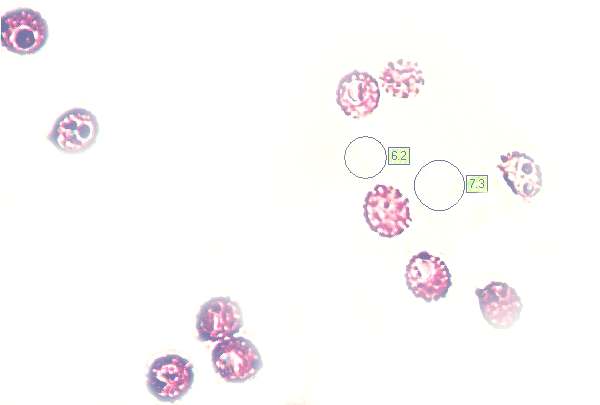Russula virescens (Schaeff.) Fr. - Greencracked Brittlegill
Phylum: Basidiomycota - Class: Agaricomycetes - Order: Russulales - Family: Russulaceae
Distribution - Taxonomic History - Etymology - Culinary Notes - Identification - Reference Sources
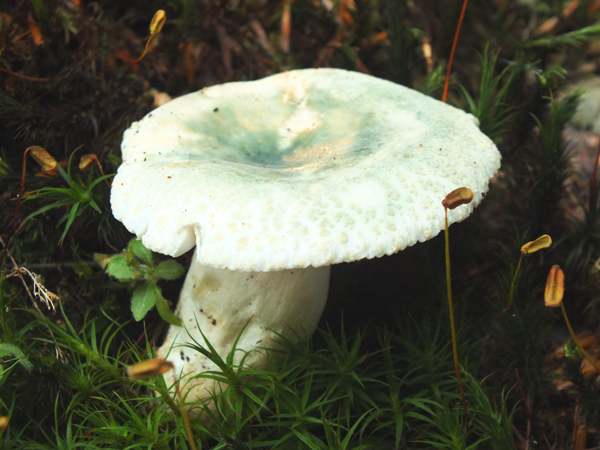
Less common, slightly larger, but otherwise similar to the Green Brittlegill Russula aeruginea and sharing the same habitat, the Greencracked Brittlegill is distinguished by a dry, velvety cap surface that breaks up into a ‘crazy-paving’ pattern. The spore print is darker than that of the more commonly encountered Green Brittlegill.
This intriguing woodland and parkland mushroom is often found under Sweet Chestnut trees, but it does also occur with other broadleaf trees.
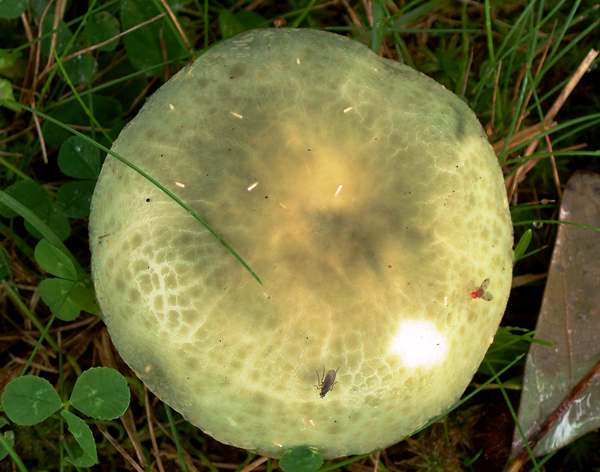
Distribution
This is an uncommon but nevertheless widespread woodland mushroom in Britain, Ireland and mainland Europe; it occurs also in much of Asia and in northern Africa. Greencracked Brittlegill mushrooms recorded in North America are also currently (2013) - Classed as Russula virescens, but DNA analysis suggests that North American Greencracked Brittlegills, which have traditionally been considered co-specific with their European lookalikes, are probably not merely one different species but a complex of two or more different species that display the 'crazy paving' or quilted cap feature.
The mature Greencracked Brittlegill shown above was growing in mixed woodland in West Wales, UK. 'Quilting' on the cap surface is just becoming visible in the young fruitbody shown on the left, which was growing in mossy grass at the edge of oak woodland on the eastern coast of the USA.
Taxonomic history
First described in 1762 by German mycologist Jacob Christian Schaeffer, who named it Agaricus virescens (most gilled fungi were placed in the Agaricus genus in the early days of fungal taxonomy), this mushroom was transferred to the genus Russula in 1836 by the great Swedish mycologist Elias Magnus Fries.
Synonyms of Russula virescens include Agaricus virescens Schaeff., Russula furcata var. aeruginosa Pers., Agaricus caseosus Wallr., and Russula virescens var. albidocitrina Gillet.
Etymology
Russula, the generic name, means red or reddish, and indeed many of the brittlegills have red caps (but many more are not, and several of those that are usually red can also occur in a range of other colours!). The specific epithet virescens means 'becoming green'.
Identification guide
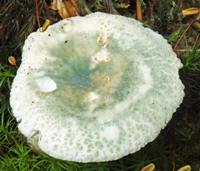 |
CapCracked, grass-green surface, paler towards margin and with green patches on a very pale green or whitish background creating a 'quilted' or 'crazy paving' effect make this a distinctive brittlegill - something of a rarity! With age the green colouring fades from the centre to a dull brownish-ochre. The cap peels 1/2 to centre; convex, flattening only in the centre, sometimes with a slight depression; greasy when moist; margin sometimes faintly grooved; 4 to 10cm across. |
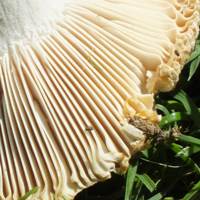 |
GillsCreamy white, turning darker with age; slightly arched, adnexed; crowded; with a few interveins. StemWhite or cream, browning with age; cylindrical, sometimes slightly fusiform, or tapering at base; 4 to 8cm long, 1.5 to 4cm dia. |
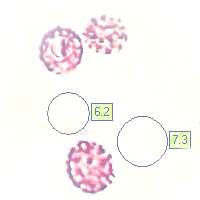 |
SporesBroadly ellipsoidal to ovoid, 7-9 x 5.5-7 µm; ornamented with small warts up to 0.5µm tall; a few ofg the warts are connected with fines lines but not forming a network. Spore printCream. |
Odour/taste |
Odour not distinctive; taste mild, nutty. |
Habitat & Ecological role |
In broadleaf woodland, particularly under Beech trees, oaks and Sweet Chestnuts. In common with other members of the Russulaceae, Russula virescens is an ectomycorrhizal mushroom. |
Season |
August to October in Britain and Ireland. |
Similar species |
Russula aeruginea the Green Brittlegill, is typically smaller but otherwise somewhat similar and occurs in the same kind of habitat; however, its cap does not crack. |
Culinary Notes
Russula virescens is one of the finest of edible brittlegills; it has a nutty flavour which is niticeably enhanced by the process of drying. These are versatile mushrooms; their firm texture and fine flavour make them ideal for sauteeing, grilling or frying with onions, but they are also very good in omelettes, soups and stews. Provided the caps are mature enough to display the distinctive quilting that is associated with this species, it is difficult to mistake this for any other woodland mushroom. (Beginners to foraging for fungi should be particularly careful to check that there is no volva or stem ring of what they believe to be a Greencracked Brittlegill.)
Reference Sources
Pat O'Reilly (2016). Fascinated by Fungi, First Nature Publishing
Geoffrey Kibby (2011).The Genus Russula in Great Britain, published by G Kibby.
Roberto Galli (1996). Le Russule. Edinatura, Milan.
Paul M. Kirk, Paul F. Cannon, David W. Minter and J. A. Stalpers. (2008). Dictionary of the Fungi; CABI.
Taxonomic history and synonym information on these pages is drawn from many sources but in particular from the British Mycological Society's GB Checklist of Fungi.
Fascinated by Fungi. Back by popular demand, Pat O'Reilly's best-selling 450-page hardback book is available now. The latest second edition was republished with a sparkling new cover design in September 2022 by Coch-y-Bonddu Books. Full details and copies are available from the publisher's online bookshop...
